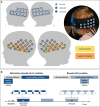The Development of Cortical Responses to the Integration of Audiovisual Speech in Infancy
- PMID: 37171657
- PMCID: PMC10176292
- DOI: 10.1007/s10548-023-00959-8
The Development of Cortical Responses to the Integration of Audiovisual Speech in Infancy
Abstract
In adults, the integration of audiovisual speech elicits specific higher (super-additive) or lower (sub-additive) cortical responses when compared to the responses to unisensory stimuli. Although there is evidence that the fronto-temporal network is active during perception of audiovisual speech in infancy, the development of fronto-temporal responses to audiovisual integration remains unknown. In the current study, 5-month-olds and 10-month-olds watched bimodal (audiovisual) and alternating unimodal (auditory + visual) syllables. In this context we use alternating unimodal to denote alternating auditory and visual syllables that are perceived as separate syllables by adults. Using fNIRS we measured responses over large cortical areas including the inferior frontal and superior temporal regions. We identified channels showing different responses to bimodal than alternating unimodal condition and used multivariate pattern analysis (MVPA) to decode patterns of cortical responses to bimodal (audiovisual) and alternating unimodal (auditory + visual) speech. Results showed that in both age groups integration elicits cortical responses consistent with both super- and sub-additive responses in the fronto-temporal cortex. The univariate analyses revealed that between 5 and 10 months spatial distribution of these responses becomes increasingly focal. MVPA correctly classified responses at 5 months, with key input from channels located in the inferior frontal and superior temporal channels of the right hemisphere. However, MVPA classification was not successful at 10 months, suggesting a potential cortical re-organisation of audiovisual speech perception at this age. These results show the complex and non-gradual development of the cortical responses to integration of congruent audiovisual speech in infancy.
Keywords: Audiovisual integration; Infant; Neurocognitive development; Speech processing; fNIRS.
© 2023. The Author(s).
Conflict of interest statement
The authors declare no competing interests.
The authors have no relevant financial or non-financial interests to disclose.
Figures



Similar articles
-
Aging, audiovisual integration, and the principle of inverse effectiveness.Ear Hear. 2010 Oct;31(5):636-44. doi: 10.1097/AUD.0b013e3181ddf7ff. Ear Hear. 2010. PMID: 20473178 Free PMC article.
-
Audiovisual speech integration in the superior temporal region is dysfunctional in dyslexia.Neuroscience. 2017 Jul 25;356:1-10. doi: 10.1016/j.neuroscience.2017.05.017. Epub 2017 May 18. Neuroscience. 2017. PMID: 28527953 Review.
-
fMR-adaptation indicates selectivity to audiovisual content congruency in distributed clusters in human superior temporal cortex.BMC Neurosci. 2010 Feb 2;11:11. doi: 10.1186/1471-2202-11-11. BMC Neurosci. 2010. PMID: 20122260 Free PMC article.
-
Degradation of labial information modifies audiovisual speech perception in cochlear-implanted children.Ear Hear. 2013 Jan-Feb;34(1):110-21. doi: 10.1097/AUD.0b013e3182670993. Ear Hear. 2013. PMID: 23059850
-
Timing in audiovisual speech perception: A mini review and new psychophysical data.Atten Percept Psychophys. 2016 Feb;78(2):583-601. doi: 10.3758/s13414-015-1026-y. Atten Percept Psychophys. 2016. PMID: 26669309 Free PMC article. Review.
Cited by
-
Resting-state functional connectivity changes following audio-tactile speech training.Front Neurosci. 2025 Apr 29;19:1482828. doi: 10.3389/fnins.2025.1482828. eCollection 2025. Front Neurosci. 2025. PMID: 40364857 Free PMC article.
-
Early selective attention to the articulating mouth as a potential female-specific marker of better language development in autism: a review.Front Psychol. 2025 Feb 5;16:1501688. doi: 10.3389/fpsyg.2025.1501688. eCollection 2025. Front Psychol. 2025. PMID: 39981392 Free PMC article.
References
-
- Aldridge MA, Braga ES, Walton GE, Bower TGR. The intermodal representation of speech in newborns. Dev Sci. 1999;2(1):42–46. doi: 10.1111/1467-7687.00052. - DOI
-
- Benjamini Y, Hochberg Y (1995) Controlling the false Discovery rate: a practical and powerful Approach to multiple testing. J Roy Stat Soc: Ser B (Methodol) 57(1). 10.1111/j.2517-6161.1995.tb02031.x
Publication types
MeSH terms
LinkOut - more resources
Full Text Sources

